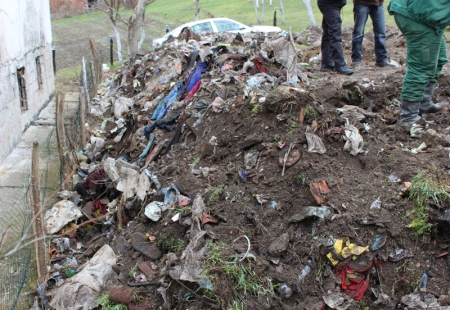BIRN’s Justice Report
5 November 2009
For the record: A Month In The Hands of Milan Lukic
Merima Husejnovic
Emina S was 22 when she fell into the hands of the Bosnian Serb
paramilitary chief who repeatedly raped her until she escaped into the
woods. She told her story to Merima Husejnovic.
—
“At the very beginning of the war I lived with my family in Visegrad,
in a place called Mahala. This is where my tragic experiences began.
One evening I went to the shop. Some soldiers, dressed in camouflage
suits, were standing in front of the building. I wanted to go back but
didn’t manage to do so. Milan Lukic and his pals stopped me and asked
what I was doing. I was instantly aware of what might happen.
He said I had to come with them. They picked me up and took me to the
spa hotel in Visegrad. When we got there, he took me out of the car
and we walked to the hotel, which was full of soldiers. The name of
the hotel was “Vilina Vlas”. I did not know the place.
As soon as we went in, I could hear the screams. I guessed that many
women had been taken there before me. There was screaming, crying,
everything … But one couldn’t move. There was nothing one could do
right then. You went in there and you did not know if you would stay
alive …
I couldn’t see anybody else in the Vilina Vlas. I knew there were
other women and they were being raped. The men were doing to them what
they wanted to do. But nobody saw anybody else. We did not know about
each other. All the rooms were closed.
Lukic did not care whether they were old or young — all he cared
about was having a woman and doing what he wanted. He would take women
for himself and then let others have them. He did not care what those
people did to the women.
He took me upstairs to a room and told me to sit on the bed, adding
that nothing would happen. It was hard. I was scared and I panicked. I
simply do not know what to do with myself.
He then ordered me to lie on the bed and take off my clothes. He did
what he wanted. It was my first time with a man. Milan Lukic took away
my virginity.
When it was over, he told me not to try to do anything because I would
not be able to escape. I realized what had happened. I did not know
what to do next.
We stayed in the room until dawn. He kept his gun next to the bed.
When he woke up I begged him to take me home. He stood up, put on his
clothes and took me with him.
We first stopped by a coffee shop. He wanted to see his pals. He took
me by my hand and took off his beret. I had long hair at the time and
he stuck the beret on my head. He said: ‘This is my future wife’,
adding that nobody should touch me.
He took me home but said I must not go anywhere because he would find
me and kill me and my whole family if I disappeared anywhere.
When I got home I felt overwhelmed by fear. I thought he would find me
wherever I went. They were everywhere. I didn’t dare go out because if
you went out, you could disappear. That is how it was.
He used to come every day. He took me with him and brought me back
whenever he wanted. He would come at night and take me away. When he
knocked on the door, my mother used to faint.
He used to take me to the pool. In the pool and by the pool …
whichever place suited him best. You had to keep quiet and pray.
It went on for a month, this exhaustion. Every day it became more and
more difficult. He would take me away and bring me back. For that
month he did whatever he wanted to do with me.
In the end I couldn’t stand it. I decided I had to run away, no matter
whether I lived or died. I couldn’t longer live with it. It was
unbearable.
So I went with my mother to the village of Okrugla, near Visegrad. We
walked through the woods before reaching the village of Dobrun. I
lived in the woods, spending my time fear because he came there
looking for me and asking people about me.
I hid in those woods until I met my present husband who helped me get
my life back. Were it not for him, I wouldn’t be alive today. I felt I
had been rejected by everybody, the whole world. I was still only 22.
That time changed my life completely. Even today my life appears good
for nothing. When I go back to Dobrun, everything reminds me of that
time. When I see the Vilina Vlas it all comes back. This is something
that cannot be erased.
Visegrad is still a nice town but it entails tragedies, a lot of
things … We lived there without any problems until 1992 when the
war began. Life will never be as it was. Years can pass and many
generations live, but nothing will be as it once was.
I am struggling to go on with my life. I have to hold on for my kids
and my family. But no matter how strong I am, I can’t overcome it. I
ask: Why did this happen to me? Why did I have to be the one?’
My first child had a shattered brain. The doctors say it may have been
due to my fears and to all the things that had stayed in me.
The only consolation for me would be to see Milan Lukic admit his
crimes. He must accept the gravity of his actions and admit his guilt.
The things that happened to me cannot be forgotten. It is different
when someone points a gun at you, but this was different. It was a
wound to the soul.”
—
The Vilina Vlas hotel is located in the woods, about 5 kilometres from
Visegrad. A rehabilitation centre and thermal spa, the Hague Tribunal
in 1992 described it as the headquarters of Milan Lukic’s paramilitary
group, the “Beli orlovi” (“White Eagles”) or “Osvetnici (“Revengers”).
A 1994 UN report on rapes in Bosnia mentioned the hotel as a detention
centre where girls as young as 14 were routinely raped. Fewer than ten
of those detained in the centre survived.
In July 2009, the Hague Tribunal sentenced Lukic to life imprisonment
for various crimes committed in the Visegrad area from 1992 to 1994 —
but rape was not one of them. The surviving victims have protested
against the court’s failure to take note of the numerous rapes
committed at various locations in Visegrad, including the Vilina Vlas.
(See: Visegrad rape victims say their cries go unheard
<http://www.bim.ba/bh/32/10/1312/>)
—
/Merima Husejnovic is a BIRN – Justice Report journalist
<merima@birn.eu.com>. Justice Report is an online BIRN weekly
publication./
“For the Record” is a special appendix to Justice Report in which we
record the life stories of people who survived horrific events in the
war in Bosnia.
The Balkan Investigative Reporting Network invites you to send us your
own memories of the war, which we will consider for publication. Write
to us at: urednik@birn.eu.com

























